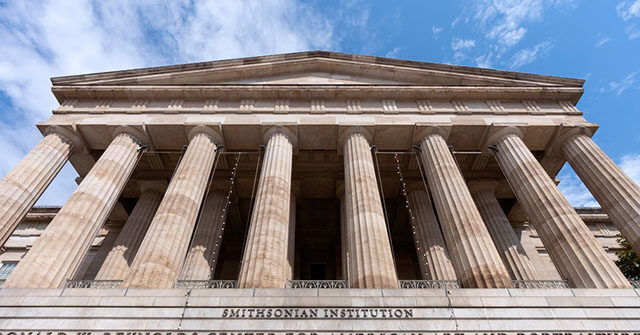In its review of Smithsonian museums, the White House has compiled several examples of what it says are overly negative portrayals of U.S. history.
In a document obtained by the Guardian, the Trump administration gives examples, based on public submissions, of troublesome exhibits at seven different museums. Some examples include a Benjamin Franklin exhibit that credits his scientific achievements to his ownership of slaves, and another example is a film about George Floyd that the administration says mischaracterizes law enforcement, according to the report.
“President Trump will explore all options and avenues to get the Woke out of the Smithsonian and hold them accountable,” a White House official told the outlet. “Until we get info from the Smithsonian in response to our letter, we can’t verify the numbers of artifacts that have been removed because the Smithsonian has removed them on their own.”
President Donald Trump announced his effort earlier this week to root out divisive ideology from Smithsonian museums.
“The Museums throughout Washington, but all over the Country are, essentially, the last remaining segment of ‘WOKE.’ The Smithsonian is OUT OF CONTROL, where everything discussed is how horrible our Country is, how bad Slavery was, and how unaccomplished the downtrodden have been — Nothing about Success, nothing about Brightness, nothing about the Future,” he said in a post to Truth Social.
“We are not going to allow this to happen, and I have instructed my attorneys to go through the Museums, and start the exact same process that has been done with Colleges and Universities where tremendous progress has been made,” he continued. “This Country cannot be WOKE, because WOKE IS BROKE. We have the ‘HOTTEST’ Country in the World, and we want people to talk about it, including in our Museums.”
Seven museums have been flagged for review, including the National Museum of American History, the upcoming National Museum of the American Latino, the National Museum of Natural History, the National Museum of African Art, the National Portrait Gallery, the Smithsonian American Art Museum, and the National Museum of Asian Art.
“The administration argues exhibits at these museums focus excessively on oppression rather than American achievements,” according to the report.
White House budget director Russ Vought sent a letter to eight museums last week requesting information about exhibits within 30 days and ordering officials to perform “content corrections” and replace “divisive” language, per the report.
Exactly which museums are under review is unclear, however, a letter the White House sent to Smithsonian Institution secretary Lonnie Bunch last week contained a different list of museums. The National Museum of American History, National Museum of Natural History, National Museum of African American History and Culture, National Museum of the American Indian, the National Air and Space Museum, the American Art Museum, the National Portrait Gallery, and the Hirshhorn Museum and Sculpture Garden, “were all up for internal review,” according to the report.
The Smithsonian Institution did not respond to the outlet’s request for comment by time of publication, but the outlet obtained a statement from Bunch to a colleague, in which she said the institution “will always be shaped by scholarship and guided by our core values.”
“While our collections may evolve to reflect new discoveries and insights, the intellectual honesty and the integrity of our research and collections will not change. Throughout our 179-year history, we have listened to and learned from our fellow citizens, as part of our mission to provide Americans with high-quality, factual content and world-class science,” she reportedly said.
“While we cannot know what future critiques will hold, I do know that I have the greatest faith in your ability to persevere and effectively represent an institution whose goal is simply to help a nation better understand its past, produce and convey the most accurate science and scholarship, and serve the greater good,” she continued.


















